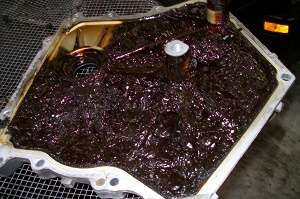4x4 Off Roading ›› Mechanical ›› Problems ›› Engine Oil Sludge
Diesel Engine Oil Sludge Build Up
SLUDGY OIL: Learn how to check your car for black oily sludge. This page explains why black gooey gel building up inside the motor is bad for diesel engines.
Sludge in engine oil can cause a significant loss in power and poor oil pressure. It can increase lube usage, overheating under load, blow-by, and dirty exhaust smoke.
The slimy goo is like tar and it can affect diesel and petrol engines. Diesel engine oil sludge is usually black. It appears as either solid gunk or gel in the motor oil.
The gelling, or solidifying, is usually caused at low running temperatures. In most cases, that means less than 100 degrees Celsius.
Car mechanics learn a lot from sludgy oil in internal combustion engines. They see sludge as a major contributing factor to common engine problems.
Sticky deposits build up. They block the normal passage of lubricant to the engine's key components. This results in excessive wear and various other damaging problems. In turn, that threatens the lifespan of your machine.
The damage caused by diesel engine oil sludge can be severe. A repair can often mean completely replacing the whole motor and its components.
What Causes Engine Sludge Build Up?
 Sludge accumulations build up for several reasons. One common cause is having a bad design (or defective) crankcase ventilation system.
Sludge accumulations build up for several reasons. One common cause is having a bad design (or defective) crankcase ventilation system.
Another common cause is running the vehicle engine at low operating temperatures.
Is there a presence of moisture or contaminated water in the oil or in the crankshaft-induced cavitation?
If so, that will also create a buildup of sticky black gel-like sludge.
Excessive sludgy engine oil gunk rarely causes a motor to seize. But, it is most likely to occur when lube changes get neglected. Running a car with very low oil levels over long periods can also cause engine oil sludge build up.
Preventing Engine Sludge
Preventing, minimizing, or removing sludge production is quite easy and inexpensive. Sludge buildup and black tar accumulation is low if you perform frequent oil changes.
Nonetheless, you should always follow the manufacturer's engine maintenance routine. Instructions vary when using mechanized flushing concentrate, de-sludging procedures, or synthetic lubricants.
We are developing a notified engine problems section from customer research. It seems that oil sludge problem are more common in Audi models, Saab, Volkswagen, and Dodge 4x4 SUV models.
Leaks that cause oil contamination will increase the likelihood of engine sludge build-up. They get built up and clog the inside of the cylinder head galleries or small passages in the block.
In turn, the engine becomes starved of the lubricant that it needs for proper function. Smaller engines generally have small mechanical compartments often combined with aluminum components.
Pro Tip: This means they have a higher heat transfer rate requiring higher engine temperatures. As they are more susceptible to overheating, they are also prone to oil sludge and gunk formation.
Using Synthetic Oils
Synthetic oils help to eliminate contaminants and reduce excessive build-up. You should combine that with regular vehicle maintenance and coolant flushing.
That can lower the probability of suffering with engine sludge. Despite not eliminating the problem altogether, regular oil changes help prevent the build-up.
Diesel Engine Oil Sludge Removal
Taking the engine apart and using kerosene can break up oil sludge to clean or remove it altogether. But, this solution may actually create further problems. So, there is a less drastic and cheaper method of trying to fix the sludge problem.
Flushing Oil Concentrate (FOC) is another solution. Anyone who changes their own oil should find it easy to use.
The formulation contains specific detergents. They target accumulations of persistent sludge and heavy deposits of carbon.
It works by dissolving the deposits and suspending them in the oil so they can get removed 'safely'. This is the best chance of restoring pristine cleanliness to an engine crankcase.
Cleaning the Crankcase and Oil
As a rule of thumb it only takes thirty minutes to flush an engine and get the job done.
- Drain the old oil out hot. That way you remove as much contaminant as possible first up and you get the best possible clean up result.
- Add fresh oil to the engine. You can use a cheap lubricant for this part of the job. Run the engine to warm up the lube and then add the flushing concentrate (125mL for 10L oil capacity).
- Run the engine at a fast idle parked up for 30 minutes. For most 4WD motors this means 1500-2000rpm and larger truck type motors run at about 1200 RPM.
- Drop the oil once more and watch all the built-up muck go out with the flush.
- Add a good quality engine oil and fit a new filter. That should last for the whole recommended service period. At this stage, many customers choose to also add AW10 Antiwear. It generally provides added protection and quieter running.
- As a final check, make sure there are no leaks, take it for a quick run, and recheck the levels.
You should now have a clean crankcase with clean lubricant. That is a step in the right direction for obtaining long engine life.
Aim for clean air and fuel by replacing filters on a regular basis. You can also clean the fuel injection system using a quality injector cleaner.
Use a reputable decarbonizer to clean up sludgy deposits in the exhaust spaces. That should complete the task of running a sludge and gunk free diesel engine.
You might also enjoy reading about...
Learning how to repair and maintain your own car means there are hundreds of tasks you can fix without having to pay for the services of a trained mechanic.